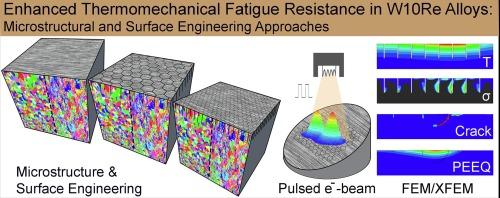Enhanced thermomechanical fatigue resistance in W10Re alloys: Microstructural and surface engineering approaches
IF 2.3
2区 物理与天体物理
Q1 NUCLEAR SCIENCE & TECHNOLOGY
引用次数: 0
Abstract
Thermomechanical fatigue of refractory metals is commonly observed in high-temperature environments like first walls and divertors for proposed fusion reactors or X-ray anodes for medical imaging. Typically, alloying with rhenium or optimized microstructures are employed to counteract or delay the detrimental effects of fatigue in tungsten. Additionally, a novel concept is the utilization of surface structures to compensate cyclic thermal stresses. This work aimed to investigate the combination of these approaches, by comparing two W10Re alloys with vastly different microstructures, as well as engineered surface conditions of varying scales. Samples were subjected to thermocyclic fatigue under pulsed electron beam exposure, mimicking the surface temperatures typically encountered in a rotating X-ray anode. Analysis of several in-situ data streams, post-mortem investigations by metallography, and finite element methods revealed the interplay between microstructure and surface modifications. The columnar microstructure exhibited higher resistance to severe surface damage compared to the globular one, linked to the deflection of cracks along grain boundaries and subsequent melting. Coarse structuring was found to partly relieve the surface stresses during thermal cycling, preventing most of the damage accumulation. A full damage relief and performance equivalence between columnar and globular microstructure was achieved by engineering fine-structured surfaces, which led to a ten-fold increase in fatigue resistance over the non-structured condition.

增强 W10Re 合金的热机械抗疲劳性:微结构和表面工程方法
难熔金属的热机械疲劳通常出现在高温环境中,如拟建核聚变反应堆的第一壁和分流器或医学成像的 X 射线阳极。通常情况下,采用铼合金或优化微结构来抵消或延缓钨疲劳的有害影响。此外,利用表面结构补偿循环热应力也是一个新概念。这项工作旨在通过比较两种具有截然不同微观结构的 W10Re 合金以及不同规模的工程表面条件,研究这些方法的组合。样品在脉冲电子束照射下受到热循环疲劳,模拟旋转 X 射线阳极通常遇到的表面温度。对多个原位数据流、金相分析和有限元方法进行的死后调查分析揭示了微观结构和表面改性之间的相互作用。与球状微观结构相比,柱状微观结构表现出更强的抗严重表面损伤能力,这与裂纹沿晶界偏转和随后的熔化有关。在热循环过程中,粗结构可部分缓解表面应力,防止大部分损伤累积。通过设计细结构表面,柱状和球状微结构之间的损伤得到了完全缓解,性能达到了同等水平,从而使抗疲劳性比无结构状态提高了十倍。
本文章由计算机程序翻译,如有差异,请以英文原文为准。
求助全文
约1分钟内获得全文
求助全文
来源期刊

Nuclear Materials and Energy
Materials Science-Materials Science (miscellaneous)
CiteScore
3.70
自引率
15.40%
发文量
175
审稿时长
20 weeks
期刊介绍:
The open-access journal Nuclear Materials and Energy is devoted to the growing field of research for material application in the production of nuclear energy. Nuclear Materials and Energy publishes original research articles of up to 6 pages in length.
 求助内容:
求助内容: 应助结果提醒方式:
应助结果提醒方式:


